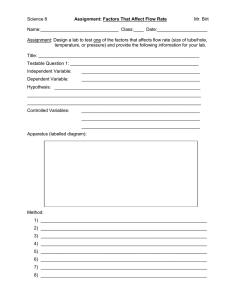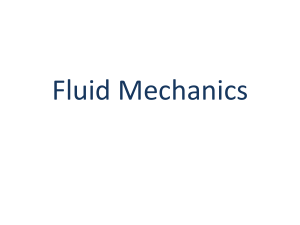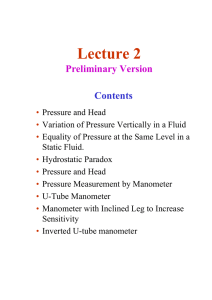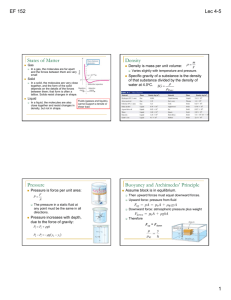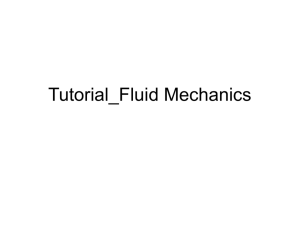Lecture 2 Final Version Contents
advertisement
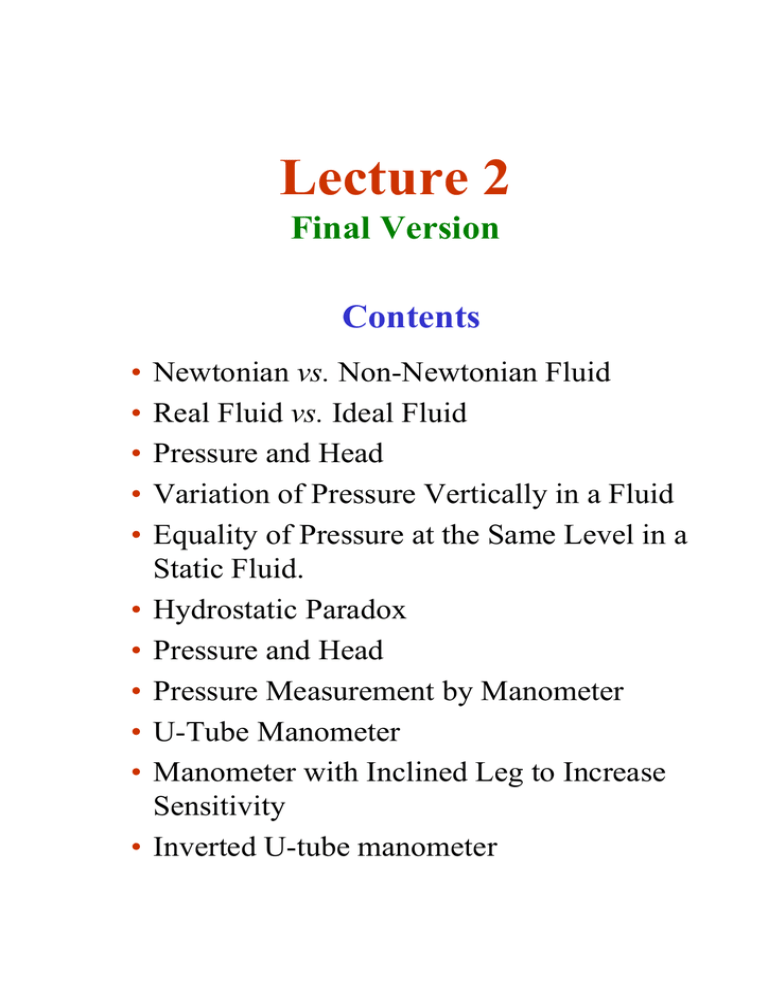
Lecture 2 Final Version Contents • • • • • • • • • • • Newtonian vs. Non-Newtonian Fluid Real Fluid vs. Ideal Fluid Pressure and Head Variation of Pressure Vertically in a Fluid Equality of Pressure at the Same Level in a Static Fluid. Hydrostatic Paradox Pressure and Head Pressure Measurement by Manometer U-Tube Manometer Manometer with Inclined Leg to Increase Sensitivity Inverted U-tube manometer What Did We Do In Last Lecture? • Characterization of a Fluid • Continuum Hypothesis • No-Slip Condition • The Boundary Layer • Viscosity • Newton’s Law of Viscosity Newton’s Law of Viscosity du τ =µ dy What Did We Do In Last Lecture? Newton’s Law of Viscosity du τ =µ dy Example 1: Example 2: Continued … CONSTANT Newton’s Law of Viscosity du τ =µ dy NEWTONIAN AND NON-NEWTONIAN FLUID Fluids behaving according to Newton’s law of viscosity are called NEWTONIAN FLUIDS (e.g. water, oil, gases) • For these fluids dynamic viscosity is constant… • … or, equivalently, shear stress is linearly related to the velocity gradient. • If viscosity not constant then NON-NEWTONIAN FLUID (blood, paints, drilling mud, polymer melts, elastomers, many emulsions) Shear Stress Rate of Shear, du/dy RHEOLOGY • The science that investigates deformation and flow of matter and the properties and molecular characteristics of fluids. • Plastic: Shear stress must reach a certain minimum value before flow commences. Thereafter, shear stress increases with rate of n shear according to ⎛ du ⎞ τ = A + B⎜ ⎟ ⎝ dy ⎠ where A, B and n are constants. If n=1, the material is known as a Bingham plastic (e.g. sewage, sludge). • Pseudo Plastic: Dynamic viscosity decreases as the rate of shear increases (e.g. colloidal solutions, clay, milk, cement). The harder I stir the softer material gets. • Dilatant Substance: Dynamic viscosity increases as the rate of shear increases (quicksand). The harder I stir the harder material gets. • Thixotropic Substance: Dynamic viscosity decreases with the time for which shearing forces are applied (thixotropic jelly paints) The longer I stir the softer material gets. • Rheopectic Materials: Dynamic viscosity increases with the time for which shearing is applied The longer I stir the stiffer material gets. • Viscoelastic Materials: Similar to Newtonian fluids under time-invariant conditions, but if shear changes suddenly behave as if plastic. Like Newtonian but gets stiffer when I hit it.. IDEAL vs. REAL FLUID • Fluids which have a viscosity (i.e. ALL fluids) are often very difficult to treat mathematically. THEREFORE, we approximate the real world... The IDEAL FLUID is a HYPOTHETICAL FRICTIONLESS and INCOMPRESSIBLE Fluid. • Ideal fluid fluid does not exist in reality, but predictions based on the concept often yield results which are useful as they are not too different from the flow of a real fluid But!!! ... Be CAREFUL … • Sometimes predictions based on an INVISCID MODEL yield results which have nothing in common with what one observes when one conducts experiment with real fluid. We will begin to discuss details later as we progress in course…. Pressure and Head •Fluid will exert a force normal to a solid boundary or any plane drawn through fluid. Pressure defined as: FORCE Pressure = AREA (Normal) Force Exerted Area of Boundary or p= F A • Note the subtle difference between definition of STRESS and PRESSURE! Stress is force ‘parallel; to area divided by the area. • Both quantities have the same dimensions, i.e. N m-2 •Usually pressure changes from point to point, hence, use ... Mean Pressure, p = δF δA •In limit, as δA → 0 δF dF = δA→0 δA dA Pressure at a Point , p = lim Variation of Pressure Vertically in a Fluid • Consider vertical column of fluid ... •Pressure force at top: F2 = p2 A •Weight of fluid in column: FW = m g = ρ g A ( z2 − z1 ) •Pressure force at bottom: F1 = p1 A In Equilibrium... p1 A − p2 A − ρ g A ( z2 − z1 ) = 0 p2 − p1 = − ρ g ( z2 − z1 ) 1442443 p2 < p1 <0 Thus, in any fluid under gravitational attraction, pressure decreases with increase of height z. Example: • Diver descends from surface of sea to depth of 30m.What would be pressure under which diver would be working above that at surface? ( Density water: ρ w = 1025 kg m −3 ) Solution: •Take sea level as datum: z1 = 0 •Since z2 is lower than z1 the value of z2 is -30m. Increase of Pressure = p2 − p1 kg = − 1025 m 3 m 9.81 s 2 (− 30 m − 0 ) N = 301.7 ×10 m2 3 • Note, atmospheric pressure at sea level is approximately 101× 103 N m2 Hence, pressure on diver increases by about: 3 x atmospheric pressure ! Something to remember: 10m water column = 1x atmospheric pressure Equality of Pressure at the Same level in a STATIC Fluid •By performing a force balance similar to the previous one but now on end planes of a horizontal cylinder … … one can show that: The pressure at any two points at the same level in a body of fluid at rest will be the same. Hydrostatic Paradox • From our example with vertical column of fluid ... z2 p2 − p1 = − ρ g ( z2 − z1 ) z1 •If free surface of a liquid in a container datum where pressure is atmospheric (i.e. reference zero) and writing: h = z 2 − z1 p1 = ρ g h Hence, pressure at bottom of a liquid filled container depends only on filling height of container! Continued... •Hence, the pressure at the bottom of the four containers is in each case: p=ρ gh h Force on Bottom = Pressure × Area = p A= ρ g h A •Thus, although the weight of the fluid is obviously different in the four cases, the force on the base of the vessel is the same, depending on the depth, h, and the base area A. Continued... Which of the two dams in sketches below has to be stronger to withstand the hydrostatic pressure? Lake, 500 km Quiescent h=20m Water Dam 1m h=20m Dam Pressure and Head •Pressure measured pressure is called ... relative to atmospheric GAUGE or GAGE PRESSURE … as distinct from the ... ABSOLUTE PRESSURE Abs. Press. = Gauge Press. + Atmosph. Press p = ρ g h + patm • If one sets patm to zero and assumes gravitational acceleration, g, as constant gauge pressure at point X in sketch can be defined by stating vertical height h, called head, of a column of a given fluid which would be necessary to produce this pressure. Pressure Measurement by Manometer •Simplest form of manometer is pressure tube or piezometer. This is a single vertical tube, open at top, inserted into pipe or vessel containing liquid under pressure which rises in tube to a height depending on pressure. •Press. at A = Press. due to of liquid of height h1 p A = ρ g h1 h1 h2 •Press. at B = Press. due to of A B liquid of height h2 p B = ρ g h2 •If liquid moving inside vessel (e.g. pipe) then bottom of tube must be flush with inside wall of vessel, otherwise reading will be affected by velocity of fluid. U-Tube Manometer •Sketch below shows what is known as a U-tube manometer. Can be used to measure pressure of gases or liquids. D A h1 B h2 ρ < ρ man C !!! (I) (II) (III) Press. pB at B = Press. pc at C Left Limb p B = p A + ρ g h1 Right Limb pC = patm + ρ man g h2 Set to zero, i.e. zero gauge Since p B = pc p A + ρ g h1 = ρ man g h2 p A = ρ man g h2 − ρ g h1 Example • U-tube manometer used to measure gauge pressure of fluid −3 P of density ρ = 800 kg m . If density of liquid Q is ρQ = 13,000 kg m −3 what will be the gauge pressure at A if (a) h1=0.5m and D is 0.9m above BC, (b) h1=0.1m and D is 0.2m below BC D A h1 (a) p A = 13.6 × 103 − 0.8 × 103 (b) kg m kg kg m kg p A = ρ man g h2 − ρ g h1 9.81 9.81 m3 p A = 13.6 × 103 − 0.8 × 103 3 3 ρ < ρ man C B For solution use: h2 m s m s2 9.81 9.81 0 .9 m 2 0.5 m = 116.15 × 103 N m −2 m s m 2 ( − 0 .2 m ) 0.1 m = − 27.45 × 103 N m −2 m3 s2 Negative sign indicates that pA is below atmospheric pressure. Example • U-tube gauge is arranged to measure pressure difference between points A and B in a pipeline. Calculate the pressure difference. B A b a h C D Solution: • Again, principle involved in calculating difference pressure is that pressure at C and D must be same. Left Limb : Right Limb : pC = p A + ρ g a p D = p B + ρ g (b − h ) + ρ man g h pC = p D p A + ρ g a = p B + ρ g (b − h ) + ρ man g h Pressure Diff.= p A − pB = ρ g (b − a ) + h g ( ρ man − ρ ) Manometer with Inclined Leg to Increase Sensitivity x z θ •If leg was vertical (i.e.θ = 90o ) then meniscus inside leg rises by z = x . •If leg inclined (i.e.θ < 90o ) then meniscus rises inside leg rises by x > z where ... sin (θ ) = z x •Since sin (θ ) → 0 x= when θ → 0 z sin (θ ) x→∞ Hence, when pressure small manometer can be made as sensitive as required by adjusting angle of inclination of leg and choosing manometer liquid with suitable density value. Inverted U-tube manometer •Used for measuring pressure differences …. x x h b a B A •Same pressure at x, … and then as usual ... Left Limb : Right Limb : p xx = p A − ρ g a − ρ man g h p xx = p B − ρ g (b + h ) pB − p A = ρ g (b − a ) + g h ( ρ − ρ man ) If A and B at same level: pB − p A = g h ( ρ − ρ man )

